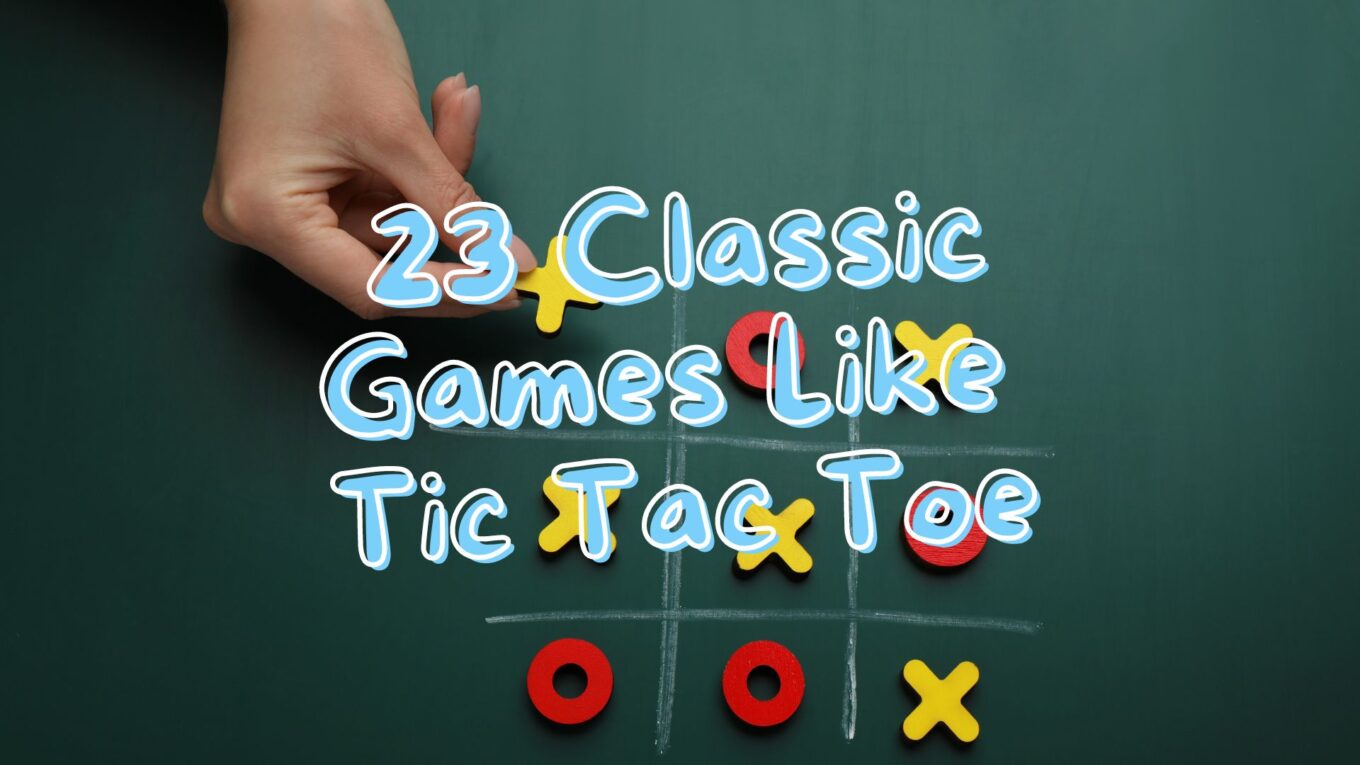Tired of the same old tic-tac-toe? We get it.
Simple games are fun, but playing the same one over and over can get boring.
Don’t worry, though. We’ve got a fix for that. In this post, we’ll show you 23 classic games like tic tac toe
that are as easy to learn and play as tic-tac-toe.
These games need only a pen and paper, making them perfect for any situation.
Whether waiting in line, on a long trip or hanging out at home, games like tic tac toe will keep you entertained.
We’ll cover everything from word games to strategy puzzles. Each game is explained simply so you can start playing right away.
Get ready to discover your new favorite pastime!
1. Ultimate Tic-Tac-Toe
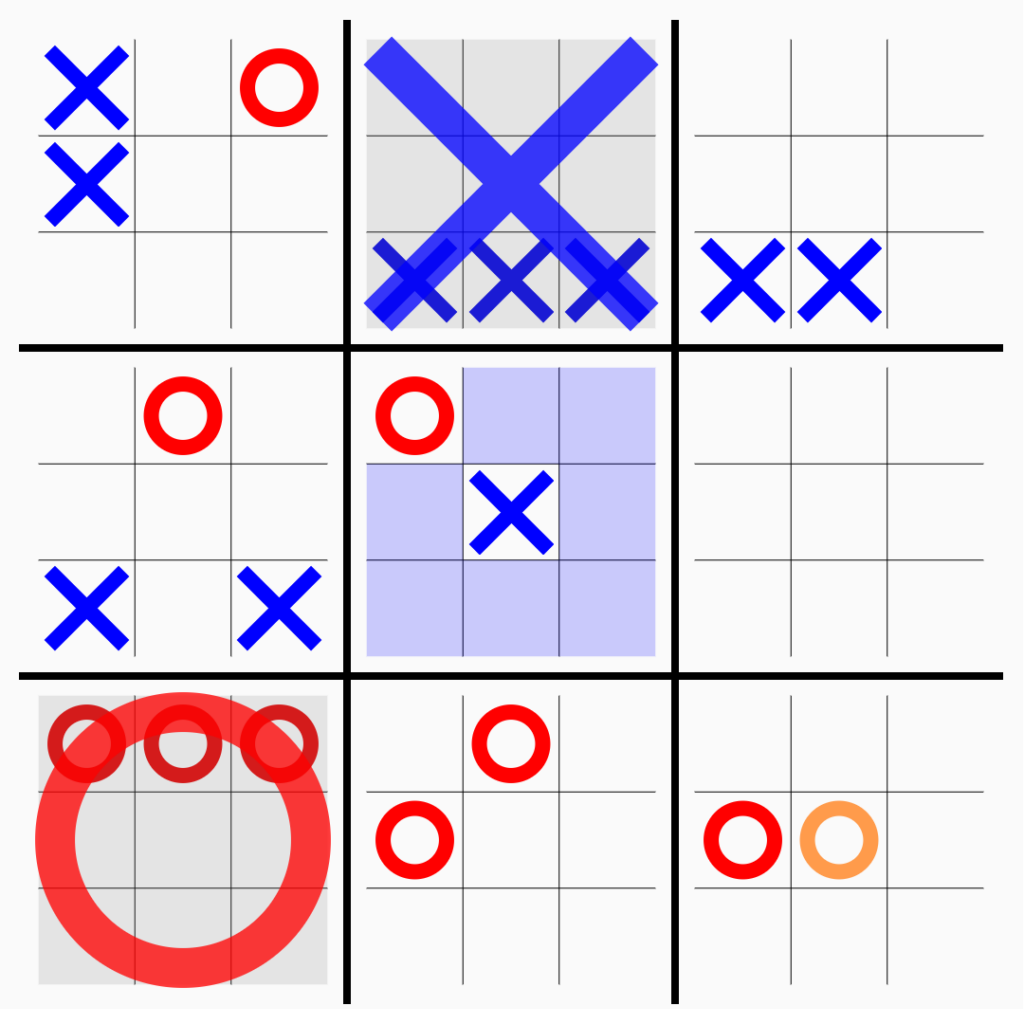
Why the Game is Popular: Ultimate Tic-Tac-Toe takes the familiar Game and adds layers of strategy, making it a hit with people who enjoy games that require deeper thinking and planning.
Age Group: 8+ years
Objective of the Game: The goal is to get three in a row on the larger 3×3 grid by winning the smaller 3×3 grids.
How to Play the Game:
- Start with a large 3×3 grid, each cell containing a smaller 3×3 grid.
- The first player places their mark in any cell of the small grids.
- This move determines where the opponent can play next in the larger grid.
- To win, a player must align three marks in a row on the large grid by winning individual smaller grids.
Tips for Spicing Up the Game:
- Try different variations by adding custom rules, such as limiting the number of turns per grid.
- Beginners should aim to control the center grid, as it offers more strategic options in the game.
- Advanced players can challenge themselves by predicting their opponent’s moves several turns ahead, like chess.
2. Dots and Boxes
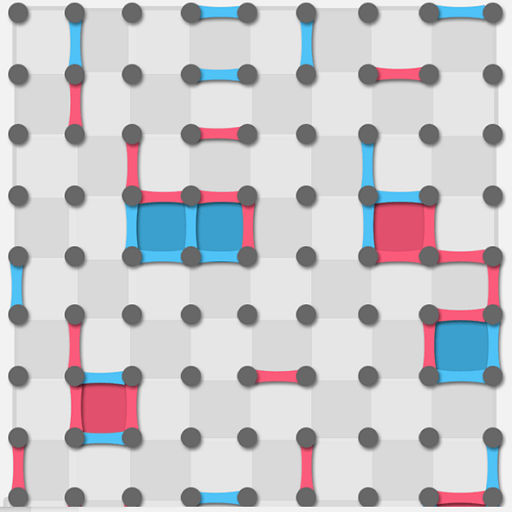
Why the Game is Popular: Dots and Boxes is a simple yet strategic game that challenges players to think ahead. It is enjoyable for both kids and adults who want to build their critical thinking skills.
Age Group: All ages
Objective of the Game: The goal is to create as many boxes as possible by connecting adjacent dots with lines and to capture more boxes than your opponent.
How to Play the Game:
- Draw a grid of dots on a piece of paper.
- Players draw lines between two adjacent dots, either horizontally or vertically.
- When a player completes a box by connecting four dots, they write their initials inside and get another turn.
- The game ends when all the dots are connected, and the player with the most boxes wins.
Tips for Spicing Up the Game:
- Use larger grids for a more challenging game.
- Experiment with different scoring methods, such as awarding extra points for creating chains of boxes.
- Focus on controlling the corners and edges of the grid to limit your opponent’s options.
- Plan your moves to set up opportunities for capturing multiple boxes in one turn.
3. Join 5
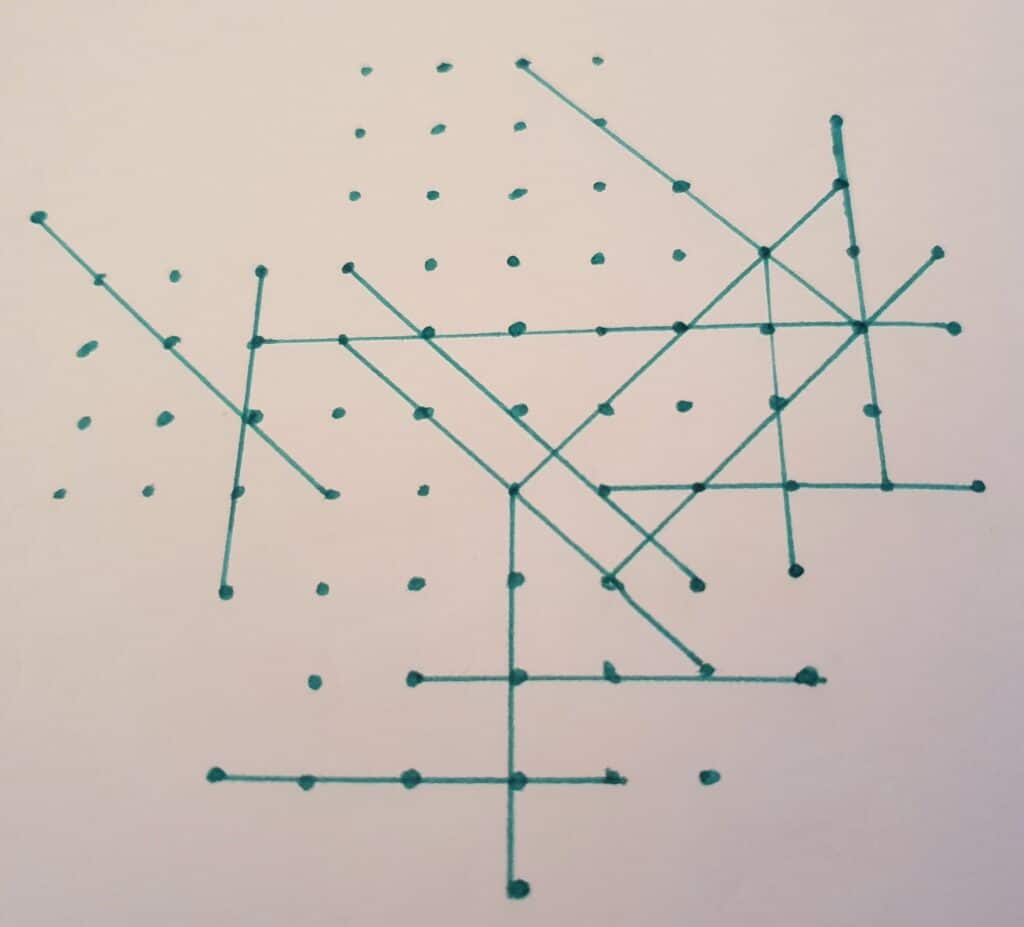
Why the Game is Popular: Join 5 is loved for its simplicity and strategic depth, making it a great brain workout for players who enjoy connecting patterns.
Age Group: 8+ years
Objective of the Game: The aim is to draw a line through exactly five dots without retracing any previous lines or crossing existing lines.
How to Play the Game:
- Start by drawing a 4×4 square of equidistant dots, with additional rectangles of dots added to each side to form a cross.
- Players take turns drawing a straight line through exactly five dots.
- The line must connect dots that haven’t been part of a line before.
- The game ends when no more lines can be drawn, and the player who made the last valid move wins.
Tips for Spicing Up the Game:
- Use dot graph paper for easier visualization and more complex setups.
- Introduce time limits per turn to increase the challenge.
- Experiment with different grid sizes and shapes to vary the difficulty.
- Focus on keeping your options open while limiting your opponent’s moves.
4. Sprouts

Why the Game is Popular: Sprouts is one of the popular games like tic tac toe, known for its mix of creativity and strategy, allowing players to use artistic and logical skills.
Age Group: 10+ years
Objective of the Game: The goal is to be the last player who can draw a line without violating the game’s rules.
How to Play the Game:
- Start by drawing 2-6 dots on a piece of paper.
- Players take turns drawing a line from one dot to another, or from a dot back to itself.
- After drawing a line, the player adds a new dot somewhere on that line.
- No line can cross an existing line; each dot can only have up to three lines connected.
- The game ends when no more lines can be drawn, and the last player to make a valid move wins.
Tips for Spicing Up the Game:
- Start with more dots for a longer, more complex game.
- Introduce time limits for each move to increase the pressure.
- Use different colored pens for each player to track moves easily.
- Develop strategies to control the placement of new dots, limiting your opponent’s options.
5. Sim
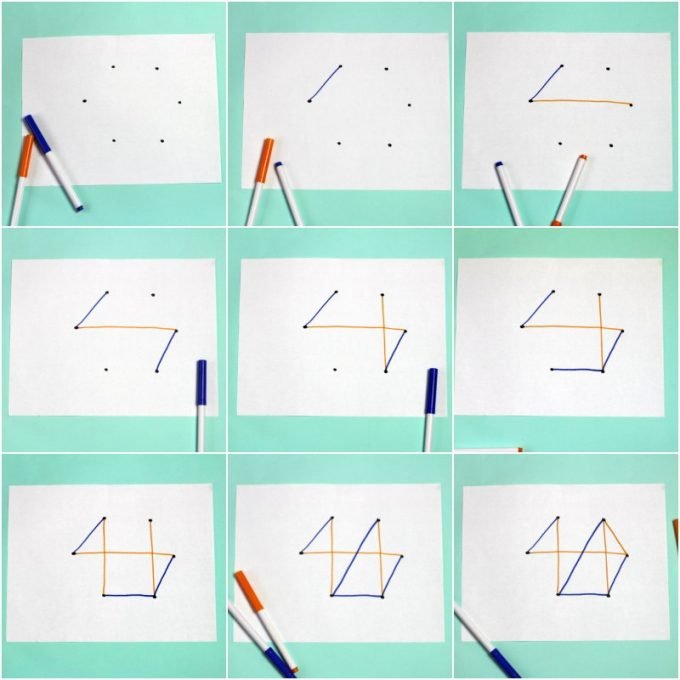
Why the Game is Popular: Sim is appreciated for its straightforward rules but challenging gameplay, making it a favorite for those who enjoy geometric puzzles.
Age Group: 8+ years
Objective of the Game: The aim is to avoid being the first player to complete a triangle with your lines.
How to Play the Game:
- Draw six points in a hexagon shape on a piece of paper.
- Players take turns drawing lines to connect any two points.
- The game continues until one player is forced to draw a line that completes a triangle with their lines, causing them to lose.
Tips for Spicing Up the Game:
- Use different colors for each player’s lines to easily identify connections.
- Increase the complexity by adding more points or changing the shape.
- Introduce a scoring system in which players earn points for forcing their opponent to make a triangle rather than ending the game immediately.
- Practice visualizing potential triangles in advance to avoid creating them.
6. Snake Game
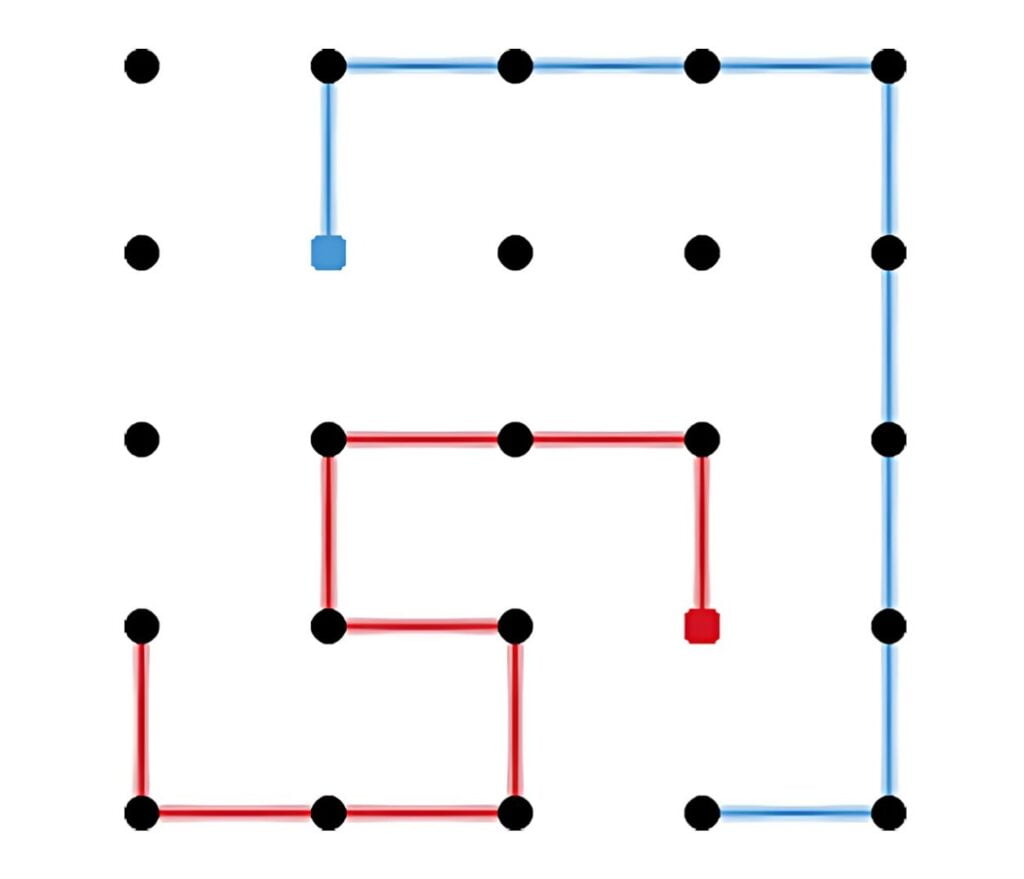
Why the Game is Popular: The Snake Game is popular because of its simplicity and its challenge to players’ spatial awareness and planning abilities.
Age Group: 6+ years
Objective of the Game: The goal is to grow your snake by adding segments each turn without crossing your or your opponent’s snake.
How to Play the Game:
- Start with a small grid on a piece of paper, and each player begins with a small snake (a single line).
- Players take turns adding one segment to their snake by drawing a line horizontally or vertically from the current endpoint to an adjacent point.
- The game ends when a player can no longer make a valid move and the player who can continue moving the longest wins.
Tips for Spicing Up the Game:
- Use a larger grid for a longer game.
- Introduce obstacles on the grid that snakes cannot cross, adding an extra challenge.
- Vary the rules by allowing diagonal moves or limiting the number of turns.
- Focus on trapping your opponent’s snake while keeping your path open.
7. Bridges

- Why the Game is Popular: Bridges is enjoyed for its strategy and spatial reasoning mix, making it a compelling challenge for puzzle enthusiasts.
Age Group: 10+ years
Objective of the Game: The goal is to build a bridge connecting different grid sections without crossing any existing paths.
How to Play the Game:
- Start by drawing an abstract shape on a paper and dividing it into 30-50 random sections.
- Players draw a bridge (a line) connecting two sections without crossing any existing lines.
- The game ends when no more bridges can be drawn, and the last player to draw a valid bridge wins.
Tips for Spicing Up the Game:
- Use different colored pens for each player to track who built which bridge easily.
- Experiment with more complex shapes and larger grids for a tougher challenge.
- Introduce a rule where bridges must be a minimum length or span a certain number of sections.
- Focus on controlling key sections early to limit your opponent’s options later.
8. Charades
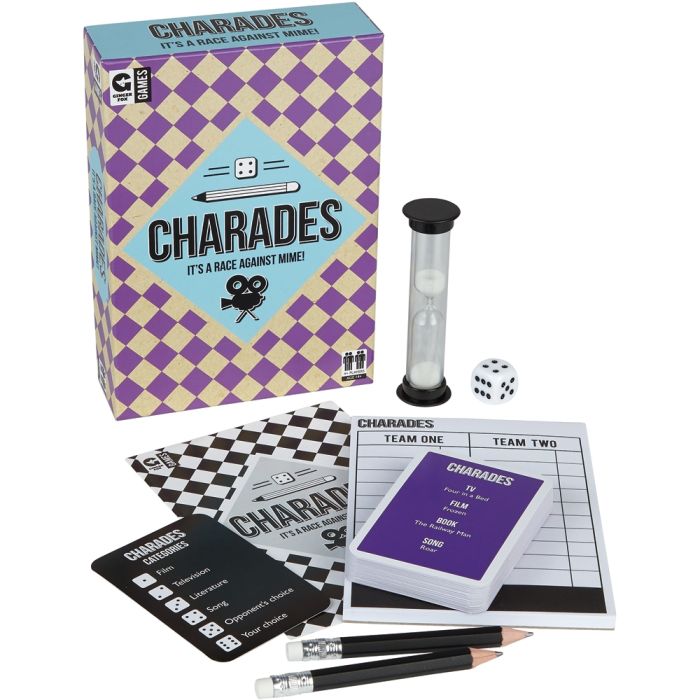
Why the Game is Popular: Charades is a lively game perfect for parties and gatherings. It encourages creativity and laughter as players act out words and phrases.
Age Group: All ages
Objective of the Game: The goal is for teammates to correctly guess the word or phrase being acted out without any verbal clues.
How to Play the Game:
- Divide into two teams and write down words or phrases on paper.
- A player from one team picks a slip and silently acts out the word or phrase while their teammates try to guess it within a set time limit.
- Points are awarded for each correct guess, and the team with the most points at the end wins.
Tips for Spicing Up the Game:
- Use themed categories such as movies, books, or famous people to add variety.
- Introduce time limits to increase the intensity.
- Try playing in reverse, where teammates describe the word without using the word itself, and the actor has to guess what they are describing.
- Include props or costumes to make the acting even more entertaining.
9. Build-a-Story
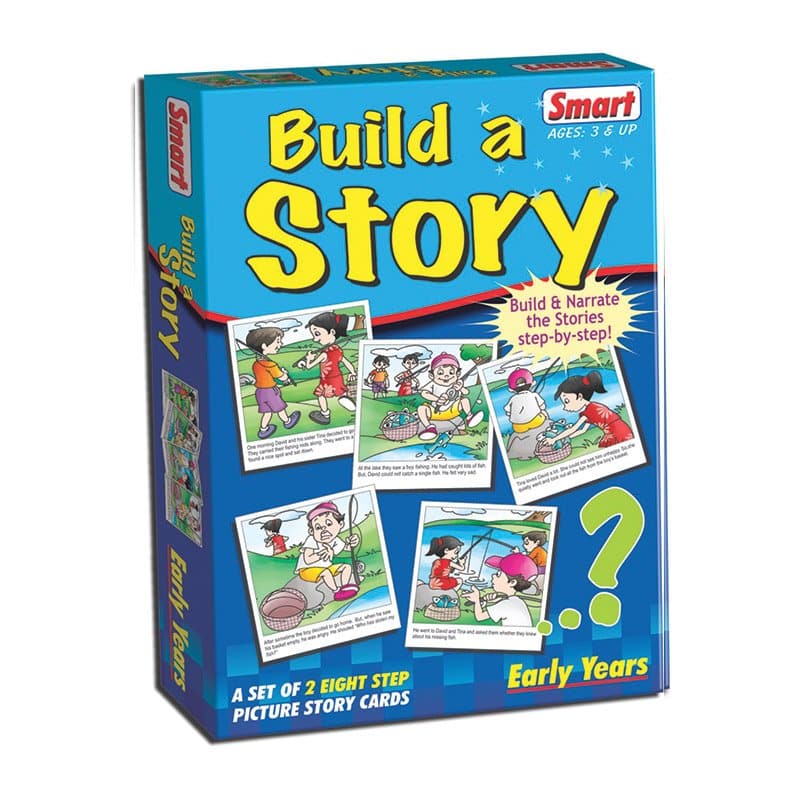
- Why the Game is Popular: Build-a-Story is beloved for its ability to spark creativity and collaboration, making it a fun and educational activity for both kids and adults.
Age Group: 6+ years
Objective of the Game: The goal is to collaboratively create a story by adding one sentence at a time, leading to a surprising and often humorous narrative.
How to Play the Game:
- Each player takes turns adding a single sentence to the story, building on what the previous player wrote.
- To add an element of surprise, players can fold the paper so only the last sentence is visible before passing it on.
- Continue until everyone has had a turn, then unfold the paper and read the story aloud.
Tips for Spicing Up the Game:
- Set a theme or genre for the story to guide creativity.
- Use a timer for each turn to keep the story moving quickly.
- Introduce “wildcard” words that players must include in their sentences.
- Encourage players to add unexpected twists to make the story more exciting.
10. Bulls and Cows
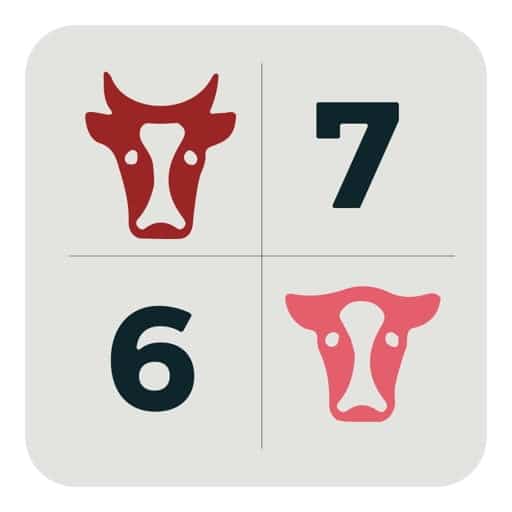
Why the Game is Popular: Bulls and Cows is popular for its blend of logic and deduction, offering an engaging and rewarding mental challenge.
Age Group: 8+ years
Objective of the Game: The aim is to guess a secret four-digit number chosen by your opponent using clues provided after each guess.
How to Play the Game:
- Each player secretly chooses a four-digit number with no repeating digits.
- Players take turns guessing each other’s numbers. After each guess, the opponent provides feedback: the number of “bulls” (correct digits in the correct place) and “cows” (correct digits but in the wrong place).
- The game continues until one player correctly guesses the other’s number.
Tips for Spicing Up the Game:
- Increase the difficulty by using five-digit numbers or allowing repeating digits.
- Set a limit on the number of guesses to increase the challenge.
- Try a timed version where players race to guess the number within a set period.
- Use a notepad to keep track of guesses and clues for a better strategy.
11. Got Your Back

- Why the Game is Popular: Got Your Back is a fun and interactive game that combines creativity and sensory skills, making it a great choice for group activities.
Age Group: All ages
Objective of the Game: The goal is to draw a picture on a teammate’s back and have them replicate the drawing on paper based on how it feels.
How to Play the Game:
- One player draws a simple image on the back of another player using their finger.
- The second player tries to replicate the drawing on a piece of paper based on the sensation of the drawing on their back.
- After everyone has drawn, compare the original drawing to the recreated ones to see how close they are.
Tips for Spicing Up the Game:
- Use a timer to add pressure and make the game more challenging.
- Try drawing more complex images as players get better at the game.
- Play in teams, where each team member takes turns drawing and guessing.
- Introduce a scoring system based on how closely the final drawing matches the original.
12. Nim

Why the Game is Popular: Nim is celebrated for its straightforward yet strategic gameplay, offering a great way to develop mathematical thinking in a fun, competitive environment.
Age Group: 6+ years
Objective of the Game: The aim is to avoid being the player forced to remove the last object.
How to Play the Game:
- Draw three rows of circles, with five, seven, and nine circles, respectively.
- Players take turns removing one or more circles from a single row.
- The game continues until no circles are left, and the player who removes the last circle loses.
Tips for Spicing Up the Game:
- Experiment with different numbers of circles and rows for a variety of challenges.
- Introduce variations where the player who removes the last circle wins instead.
- Add a time limit for each move to increase the intensity.
- Practice different strategies to force your opponent into a losing position.
13. Connect Four
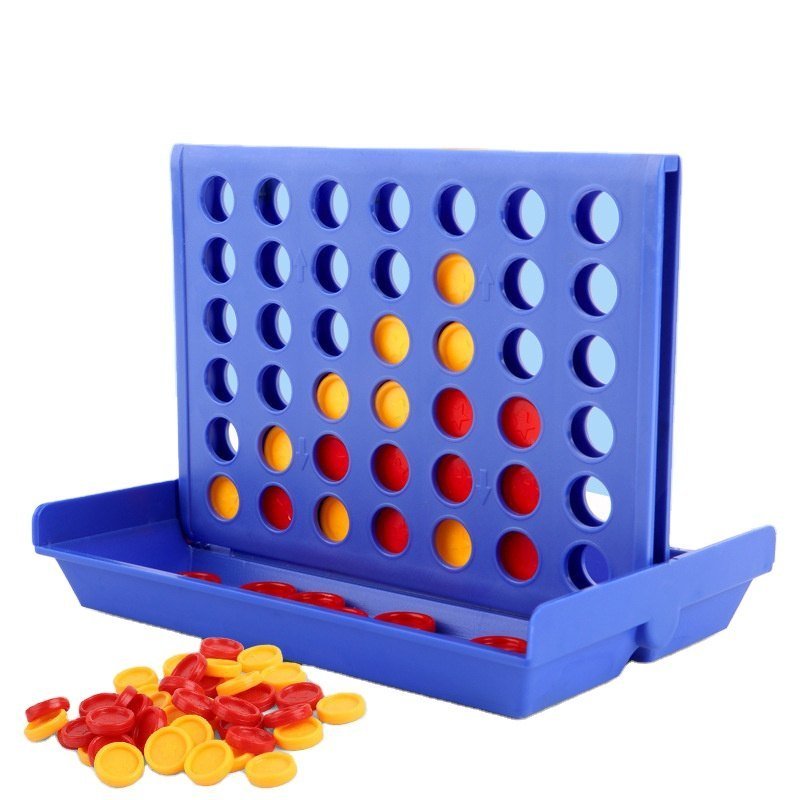
Why the Game is Popular: Connect Four is a widely recognized game that combines simplicity with strategic depth, making it a favorite for family game nights.
Age Group: All ages
Objective of the Game: The goal is to be the first to connect four of your discs in a row, either horizontally, vertically, or diagonally.
How to Play the Game:
- Players take turns dropping colored discs into a vertical grid.
- The discs fall to the lowest available slot in the chosen column.
- The first player to connect four of their discs in any direction wins the game.
Tips for Spicing Up the Game:
- Try playing with different-sized grids for varied difficulty.
- Introduce a rule where players must alternate between horizontal and vertical strategies.
- Use a time limit per move to keep the game fast-paced.
- Focus on blocking your opponent’s potential connections while setting up your own.
14. Spaceman (Hangman Variant)
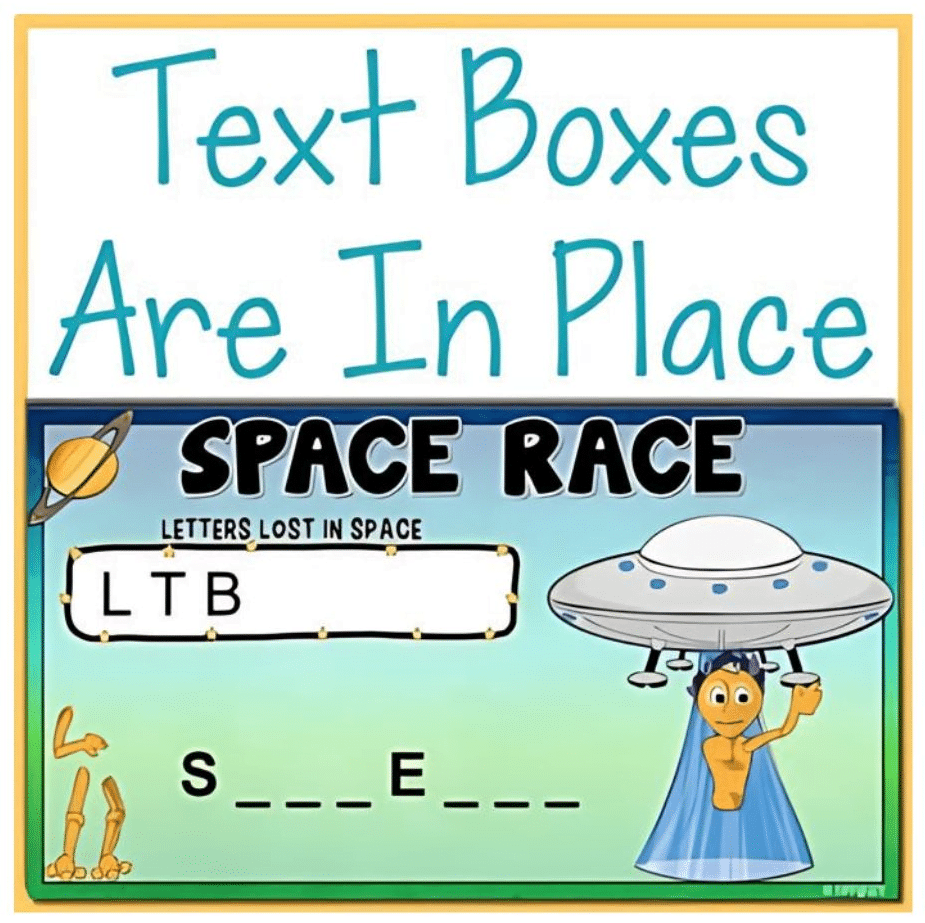
Why the Game is Popular: Spaceman is a fun twist on the classic Hangman game, adding a creative theme that appeals to players of all ages.
Age Group: 6+ years
Objective of the Game: The goal is to guess the hidden word before the drawing of the spaceman is completed.
How to Play the Game:
- One player thinks of a word and writes a series of dashes on paper, each representing a letter in the word.
- The other players take turns guessing letters.
- Correct letters are filled in on the dashes; incorrect letters result in the addition of a part of the spaceman’s drawing.
- The game ends when the word is guessed or the spaceman is fully drawn.
Tips for Spicing Up the Game:
- Use categories like movies, animals, or sports to guide guesses.
- Introduce a “hint” option where players can ask for a clue in exchange for a penalty, like adding an extra part to the spaceman.
- Play with a time limit for each guess to add excitement.
- Try drawing different characters instead of a spaceman, like a snowman or robot.
15. Sliding Puzzle
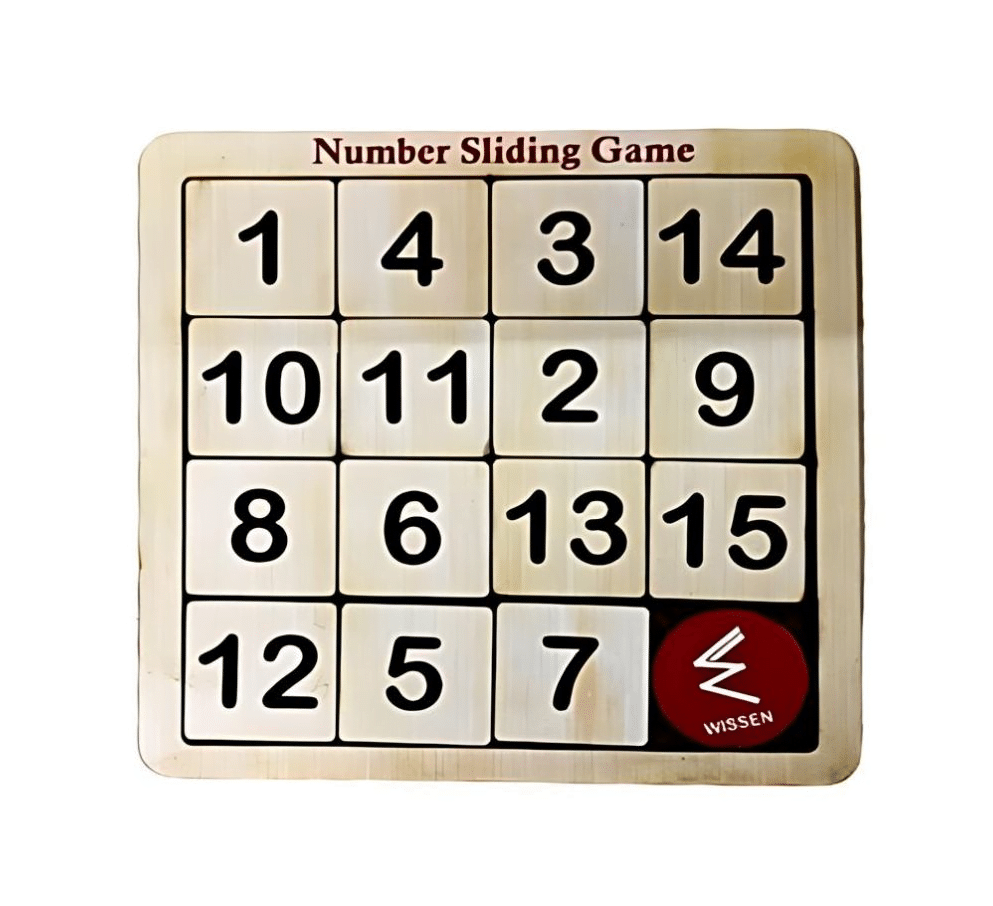
Why the Game is Popular: Sliding Puzzle is a classic brain teaser that challenges spatial reasoning and sequential thinking. It is popular for both solo play and friendly competition.
Age Group: All ages
Objective of the Game: The goal is to slide the tiles around to arrange them in the correct numerical order.
How to Play the Game:
- Start with a grid of tiles numbered 1 through 15, with one space.
- Slide the tiles one at a time into the space to rearrange them in numerical order, from top left to bottom right.
- The game ends when all tiles are in the correct order.
Tips for Spicing Up the Game:
- Try solving the puzzle within a time limit for an added challenge.
- Use different-sized grids for varying difficulty levels.
- Introduce a scoring system based on the number of moves it takes to solve the puzzle.
- Compete against others to see who can solve the puzzle the fastest.
16. Erase Numbers
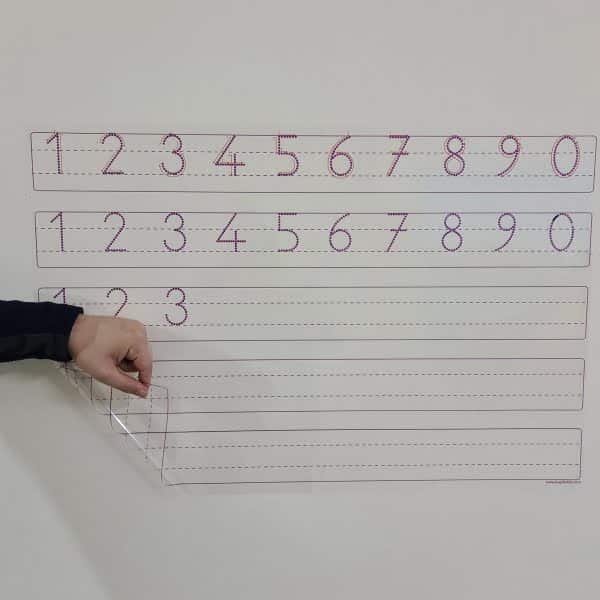
Why the Game is Popular: Erase Numbers is a unique and strategic game that challenges players to think carefully about each move, making it engaging and mentally stimulating.
Age Group: 8+ years
Objective of the Game: The goal is to avoid being the player who is forced to erase the last zero.
How to Play the Game:
- Each player writes a sequence of numbers from 0 to 9 on a piece of paper.
- On their turn, a player can either decrease a number in the sequence or erase any zero and all numbers to the right of it.
- The game continues until no more moves can be made, and the player who erases the last zero loses.
Tips for Spicing Up the Game:
- Use longer sequences of numbers for a more challenging game.
- Introduce additional rules, such as allowing players to remove multiple numbers simultaneously.
- Try a timed version where players must make their moves quickly.
- Focus on strategically reducing numbers to limit your opponent’s options.
17. Paper Football

Why the Game is Popular: Paper Football is a simple and fun game perfect for passing the time, especially in classrooms or gatherings. It’s easy to set up and can be played almost anywhere.
Age Group: All ages
Objective of the Game: The goal is to flick a folded paper football across a table, trying to land it in a scoring position or through an upright goal made by your opponent’s fingers.
How to Play the Game:
- Fold a piece of paper into a small triangle to create the football.
- Players take turns flicking the football across a table, aiming to get it to hang over the edge of the table without falling off to score a touchdown.
- Players can attempt to flick the football for extra points through a goal made by the other player’s hands.
Tips for Spicing Up the Game:
- Introduce a point system where different parts of the table represent different scores.
- Try playing on different surfaces for varied challenges.
- Use different sizes or shapes of paper footballs to change up the gameplay.
- Add a time limit for each flick to increase the tension.
18. Jet Planes
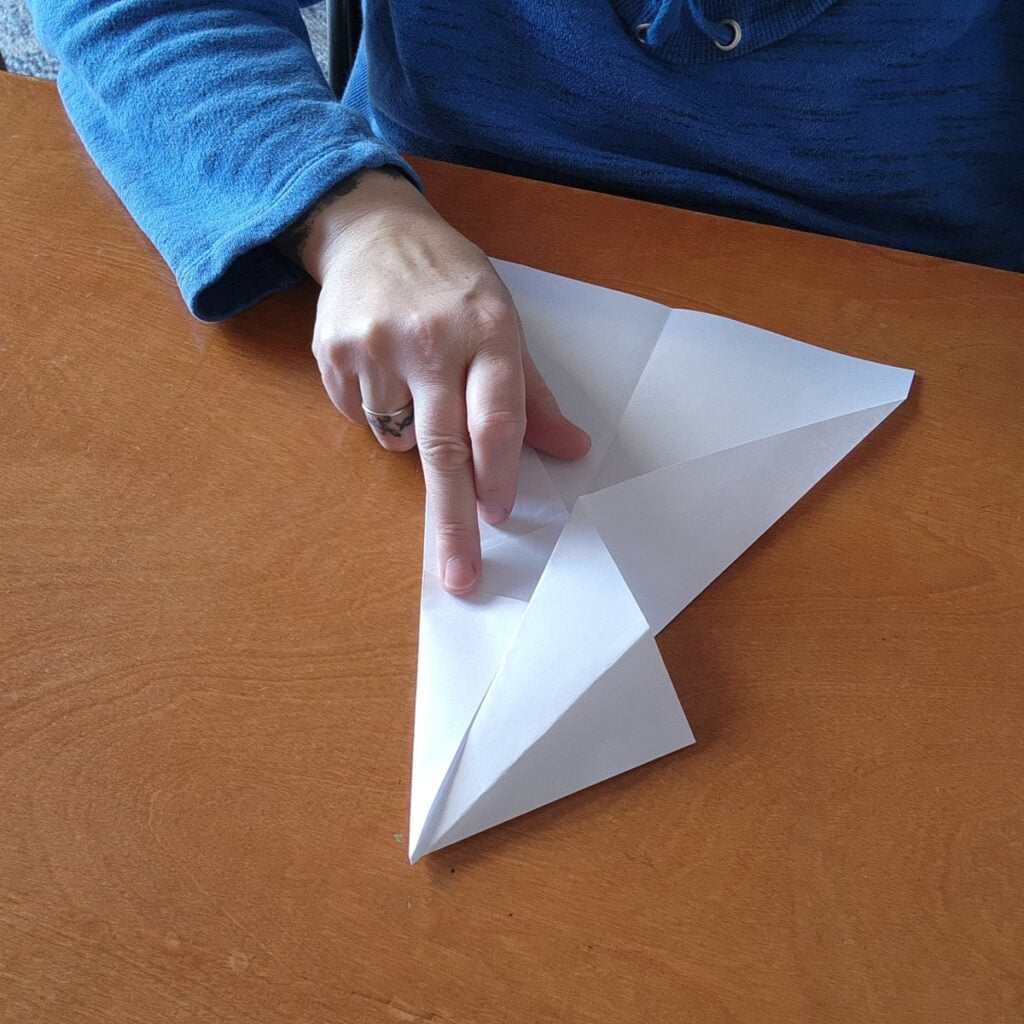
Why the Game is Popular: Jet Planes is popular because it combines creativity with friendly competition, making it a fun activity for all ages.
Age Group: All ages
Objective of the Game: The goal is to create paper airplanes and see whose plane can fly the farthest or perform the best tricks.
How to Play the Game:
- Fold a piece of paper into an airplane using any design you prefer.
- Players then take turns flying their planes to see whose plane goes the farthest or performs specific tricks like loops or sharp turns.
- Points can be awarded based on distance, accuracy, or creativity.
Tips for Spicing Up the Game:
- Try using different types of paper to see how it affects flight.
- Introduce challenges like flying through a target or landing on a specific spot.
- Hold a competition where planes are judged on style and distance.
- Experiment with different folding techniques to create unique airplane designs.
19. Balderdash

Why the Game is Popular: Balderdash is popular for its blend of creativity and bluffing, making it a fun and social game that can lead to many laughs.
Age Group: 10+ years
Objective of the Game: The goal is to guess the correct definition of a word among a selection of fake definitions created by other players.
How to Play the Game:
- One player, the “judge,” selects a word from a dictionary or word list that is likely to be unfamiliar to most players.
- The other players write down fake definitions for the word, trying to make them sound believable.
- The judge then reads all the definitions, including the correct one, and players vote on which they think is correct.
- Points are awarded for guessing correctly and fooling others with a fake definition.
Tips for Spicing Up the Game:
- Use obscure or old-fashioned words to increase the challenge.
- Introduce a time limit for writing definitions to keep the game moving.
- Award extra points for particularly creative or funny fake definitions.
- Use themed word lists, such as medical terms or historical jargon, for added variety.
20. Beetle
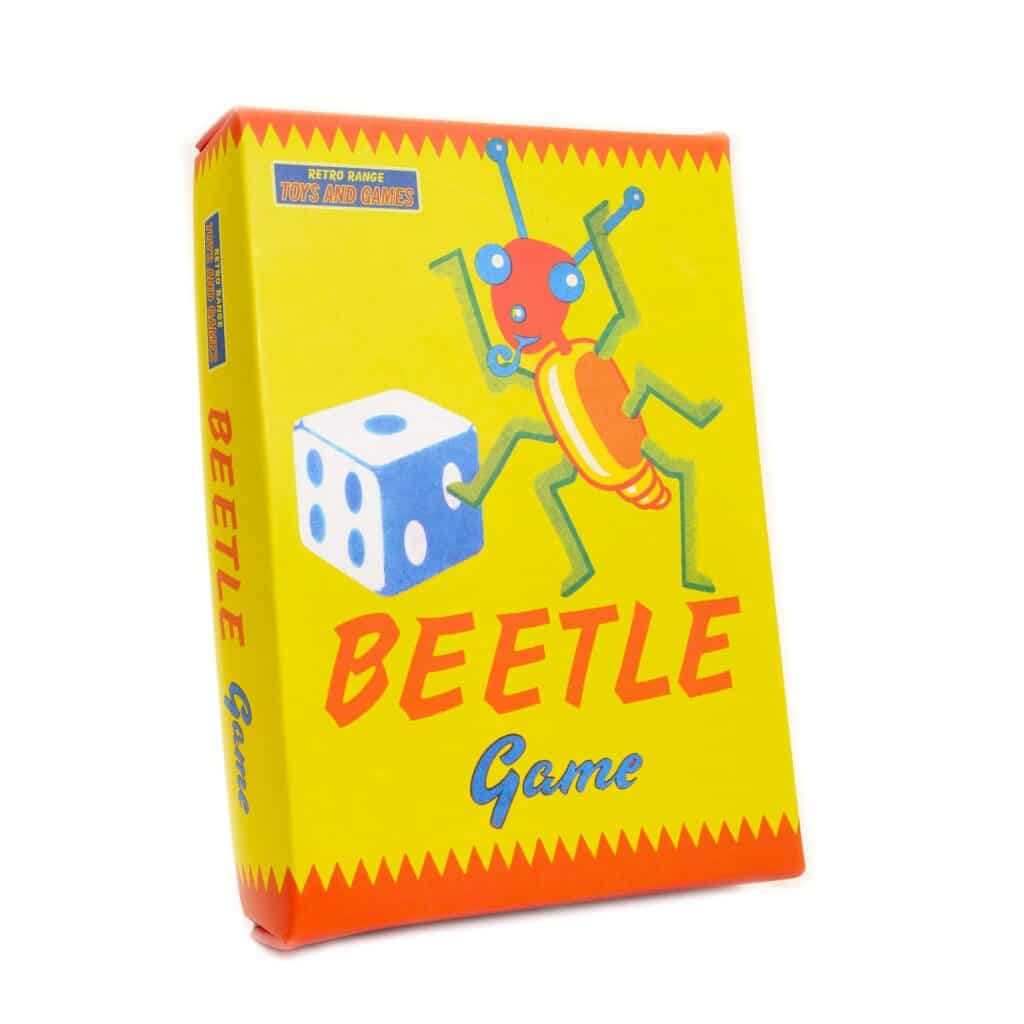
Why the Game is Popular: Beetle is a simple and enjoyable game that combines luck with creativity, making it a hit with children and families.
Age Group: 6+ years
Objective of the Game: The goal is to be the first player to complete a beetle drawing by rolling the correct numbers on a die.
How to Play the Game:
- Players take turns rolling a die. Each number on the die corresponds to a specific part of the beetle’s body (e.g., 1 for the body, 2 for the head, etc.).
- Players must roll each number to draw the corresponding part of the beetle, with the body being drawn first.
- The first player to complete their beetle wins the game.
Tips for Spicing Up the Game:
- Try drawing different animals or characters instead of a beetle.
- Introduce a rule where players can steal a part from another player’s beetle if they roll a specific number.
- Use colored markers or crayons to make the drawings more vibrant.
- Add a time limit to increase the urgency of each roll.
21. Telephone Pictionary
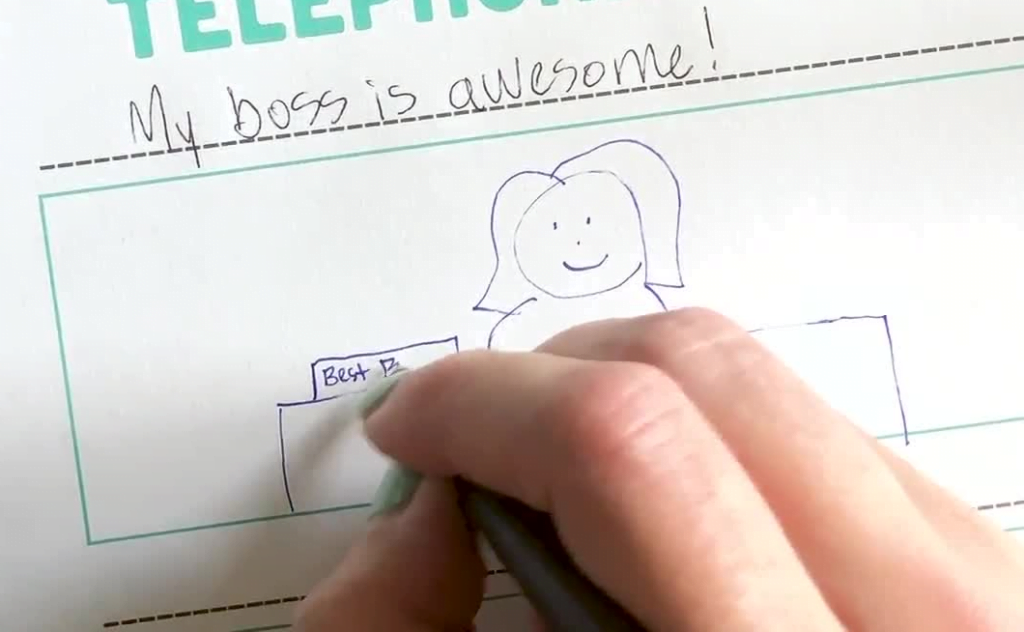
Why the Game is Popular: Telephone Pictionary is popular for its combination of drawing and storytelling, leading to hilarious and unpredictable results that are perfect for group gatherings.
Age Group: All ages
Objective of the Game: The goal is to see how a phrase or drawing evolves as it is passed from player to player, creating a fun and often funny result.
How to Play the Game:
- Each player starts with a piece of paper and writes a sentence or phrase at the top.
- They then pass the paper to the next player, who draws a picture representing the sentence.
- The paper is then folded to hide the original sentence, and the next player writes a new sentence based on the drawing.
- This process continues until the paper is full, at which point the entire sequence is revealed and shared with the group.
Tips for Spicing Up the Game:
- Use themed phrases or drawings to guide the game.
- Introduce a time limit for each turn to keep the game moving quickly.
- Play in larger groups to create more elaborate and unexpected final results.
- Try using more complex or abstract phrases to make the game more challenging.
22. Mastermind
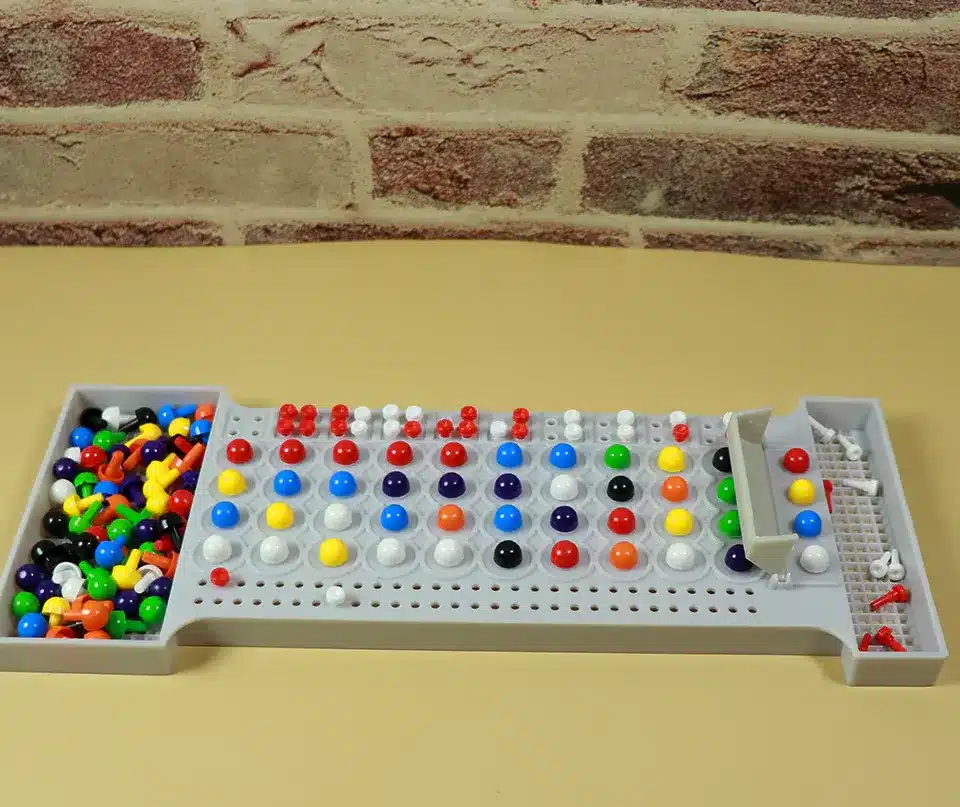
Why the Game is Popular: Mastermind is popular for its challenging gameplay, which requires logical thinking and deduction. It is a great game for puzzle enthusiasts.
Age Group: 8+ years
Objective of the Game: The goal is to guess the secret code created by your opponent within a set number of attempts.
How to Play the Game:
- One player, the “code maker,” creates a secret code using a series of colored pegs or numbers hidden from the other player, the “codebreaker.”
- The codebreaker then attempts to guess the code by placing their pegs or numbers in a sequence.
- After each guess, the code maker provides feedback, indicating how many pegs are the correct color and in the proper position (using white or black pegs as markers).
- The game continues until the codebreaker correctly guesses the code or runs out of attempts.
Tips for Spicing Up the Game:
- Increase the difficulty by adding more colors or pegs to the code.
- Introduce a time limit for each guess to add pressure.
- Allow multiple codebreakers to compete against each other simultaneously.
- Try using numbers instead of colors for a different type of challenge.
23. MASH
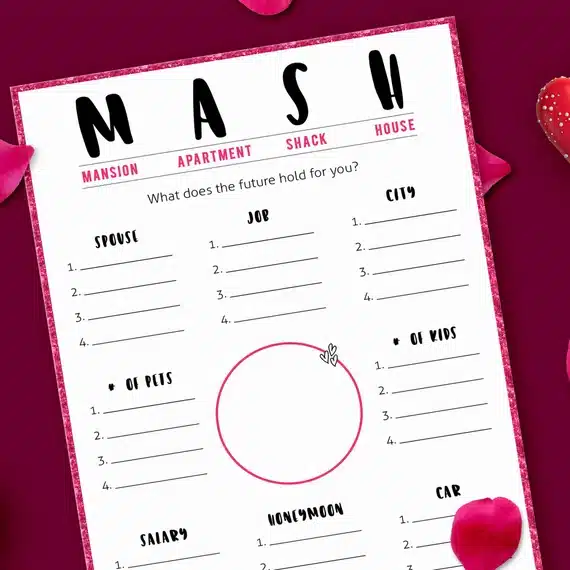
Why the Game is Popular: MASH is a nostalgic game popular for its lighthearted approach to predicting your future, making it a fun activity for kids and teenagers.
Age Group: 8+ years
Objective of the Game: The goal is to predict your future by selecting options for categories like career, number of children, and type of home.
How to Play the Game:
- Start by drawing a chart with the word “MASH” at the top, which stands for Mansion, Apartment, Shack, and House. Add other categories like spouse, job, number of kids, and car.
- Players then choose a number, and the other player counts through the options, eliminating them as they go, until only one option remains in each category.
- These final choices represent the player’s “future.”
Tips for Spicing Up the Game:
- Use themed categories like “Celebrity Lifestyle” or “Fantasy World” to make the game more interesting.
- Introduce wildcards that allow players to swap one of their final options with a new one.
- Play in a group and compare everyone’s results for added fun.
- Try using a random number generator or dice to select the counting number.
Conclusion
These 23 games like tic tac toe, offer more than a way to pass the time. They sharpen your mind, test your skills, and bring people together.
From the strategic depth of Ultimate Tic-Tac-Toe to the word-guessing fun of Spaceman, there’s something for everyone.
These games like tic tac toe prove you don’t need fancy equipment or complicated rules to have a good time. All you need is a pen, paper, and a willing partner.
So next time you’re bored, skip the phone and try one of these games instead.
You might find a new favorite. Remember, the joy of these games isn’t just in winning but in the laughs and memories you make along the way.
Why not challenge a friend to a game right now?

